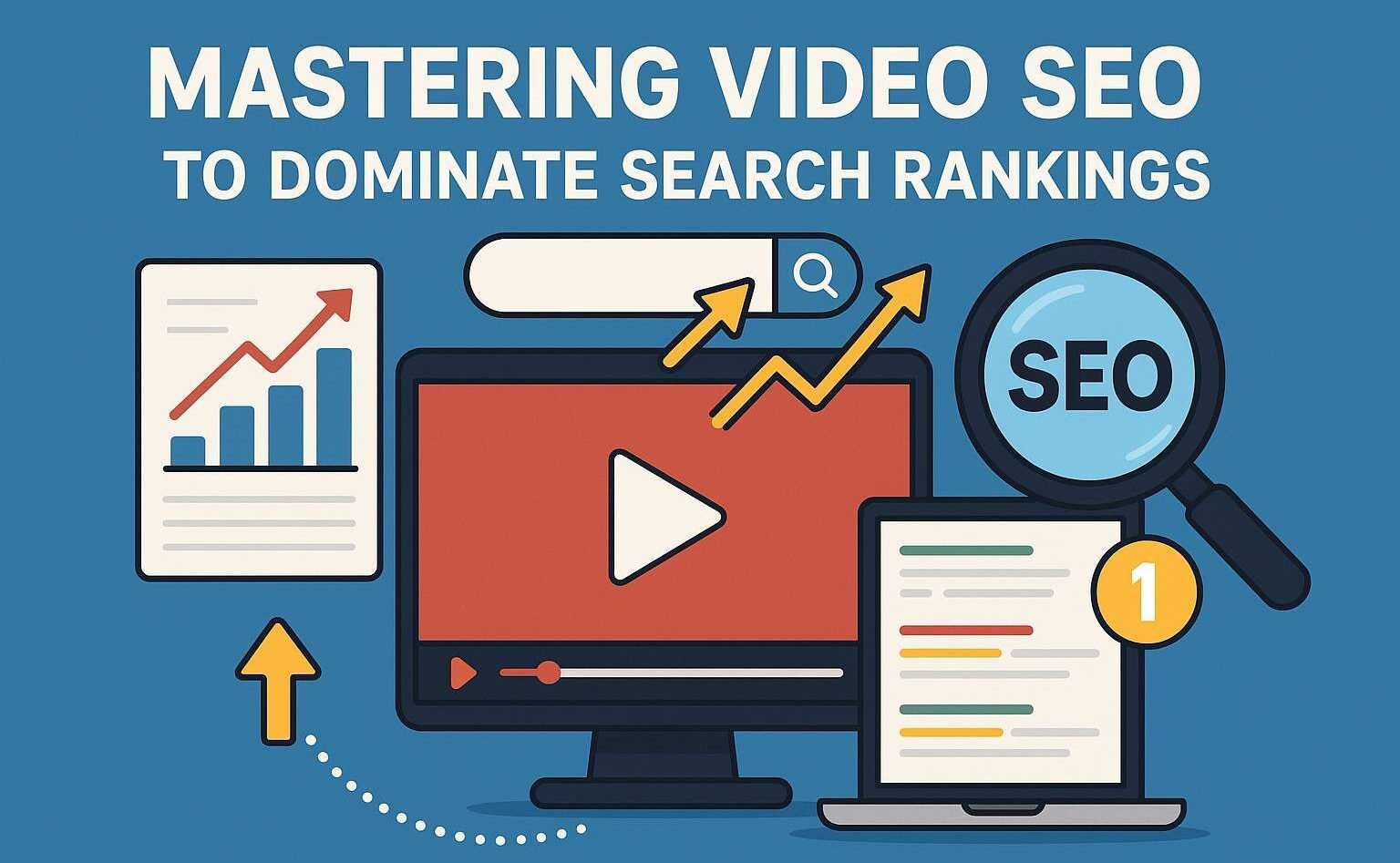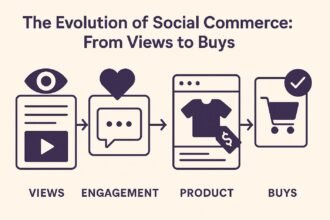Introduction to Video SEO
Master Video SEO: Strategies to Rank Higher and Drive Engagement
Rank higher and drive engagement. In 2025, video SEO will be primarily about user engagement: watch time, clicks, and social-sharing signals. Those factors are essential to the health of the video ecosystem, and they’ll guide search engines in deciding which videos deserve to appear at the top of the results page.
The content, hosting, delivery and production of video are all necessary factors for Video SEO—but the priority is on their effect on user engagement. Distribution and Promotion of video are essential for driving traffic, but engagement signals—Traffic Sources, ConvertKit, Video, Open Rate and Video, Click-Through Rate—are critical for determining where a video ranks in search results. Optimize those signals, and the content creation and technical SEO of videos flow naturally into a logical pattern.
Why Video SEO Matters in 2025
The search experience for video is changing. While video remains a highly desirable content format, both search engines and users are evolving toward a more sophisticated search experience, thereby reducing the effectiveness of some common video SEO strategies. Video searches accounted for approximately 40% of all searches in 2023, and search engines understand how video content enhances the satisfaction of those searches. Google now serves more searches using an answer box, and video content accounts for a large percentage of all video views. Users are increasingly searching for specific answers and prefer to watch short video responses instead of reading long articles. These shifts in the search ecosystem are reflected in the alarming decline in website traffic for many publishers as the big platforms pull search traffic toward their core properties while also reducing the number of organic results shown. It truly isn’t what you know; it’s what you can show.
Market leaders recognize the importance of producing video content that is faster and easier to consume. For eCommerce, the ability to ignore written reviews is no longer limited to Gen Z. Viewing short video clips about products is more convincing and engaging than reading text-based reviews. Video captures the attention of users and keeps them engaged longer. Longer engagement reduces bounce rates, which positively influences quality scores, conversions, and ROIs. In 2024, 88% of marketers reported that video ROI is a success, gathering more likes, shares, and comments than other types of content. The quantity of video content produced and consumed across social media platforms is increasing, which means that video producers must work harder to create eyeball-catching content.
Key Ranking Factors for Video Content
These three core elements—relevance, engagement, and signals—tightly interconnect with the detailed recommendations for optimizing video’s metadata, technical SEO, and distribution discussed later.
All forms of content are evaluated based on how well they serve a query. But video content doesn’t just have to be relevant; it also needs to engage the viewer for an extended period of time. Extended engagement is a primary indicator of video relevance, but it’s not the only one. Videos also receive engagement signals directly from the user interface—likes, shares, embeds, comments, and so on. And there are plenty of indirect signals as well. Other pages with high-authority link profiles often point back to them, and viewers actively search for, subscribe to, and reference video publishers. These counts are critically important to large-volume search traffic keywords, but they matter for more obscure queries as well. The reason is simple: the more “pull” that a video channel or site has (that is, the more willing the audience is to actively seek out content), the more the search engines will prioritize them for high-reward, high-risk keywords.
The Map for Video SEO Below provides a roadmap for building and optimizing videos, both for the finished product itself and for the process that creates it. It starts with keyword research and audience analysis, mapping a keyword framework to video keywords and listening for potential topics. Then, once the content has been created, it discusses the metadata—titles, descriptions, thumbnails, chapters—and places all of this in the broader context of video watch time, length, technical implementations, hosting considerations, and distribution.
Keyword Research and Planning
Video content is often at the bottom of the keyword funnel when it comes to search intent. Short-tail terms that could rank highly for video usually align with “entertainment” focus rather than “informational.” Short-tail keywords are strongly optimized for specific, directed user intent, while long-tail targeting outlines contextual understanding—think of signatures like “video education, tutorials, documentary, purpose built, etc.”
Identifying Target Keywords for Video
Ranking well in search results means being relevant to the search query. Thus, selecting the right keywords is an essential step in last-gestation video content that strongly instructs the viewer. Three basic concepts define how terms are selected and matched with video content for search engines. Depending on your customer base, either short-tail or long-tail keywords may serve as targets. Short-tail conditions offer high potential search numbers but may not match well with any one video. Users could reach the page by searching almost anything with a video keyword factor. A well-matched key word may be more useful as a long-tail term. Long-tail conditions will not provide matching totals on a particular phrase but will tend to match closely the intent of the user. Therefore, longer phrases that contain the same three or four keywords as short-tail terms may also serve in search. To get positive results, a base keyword list divided into primary and secondary clusters can identify feeding topics for short and long-tail phrase selection.
Examining the connectedness of words clarifies the organization behind a keyword list. Important subjects appear more frequently across groupings while insignificant topics seem only in single clusters. The output of this exercise determines the position of a video within a topic cluster. Its key term matches directly with the video cluster indication within the keyword framework. Secondary clusters from additional videos or non-video content presented at the same stage can inform video chapter breaks. All keyword clustering is mapped against the full scope of these terms. Clusters have been created for guides through Video SEO Measurement, so the series creation or presentation of multiple series obliges no further keyword clustering. Each individual phrase attempting search remains linked to the complete keyword table, permitting activity mapping for research and intent selection, while maintaining keyword discovery from search-based action.
Search Intent and Content Mapping
Addressing search intent means mapping keywords to general video topics, specific content chapters (if applicable), and video on-page signals—in particular, thumbnails, titles, and descriptions. Keyword Groups play a critical role at this point in the process. Their incorporation of surface-level and semantic variations aligned to a keyword’s intent allows for planning comprehensive content that satisfies viewers’ needs for granular answers, even within a broader topic.
Once a Keyword Group has been established, the original keyword in that group can derive appropriate chapters, if relevant. And common-sense mapping of the main signal areas—thumbnail, title, and description—further ensures that users and search engines quickly identify if—and how—a video satisfies the query.
Competitor Analysis for Video SEO
Deciding what to benchmark and against which competitors is vital. Bear in mind that the WordPress, Semrush, and Terminal X descriptions in the introductions are rather different in their format—WordPress’s Benjamin for example adopts a 4K-res sort of visual to hammer home the video—so even depth profile becomes a factor. Metrics that lend themselves to easy evaluation include • Ranking. If a dozen spotters for their descriptors are weighing finales and turns more comparative than awarding, the watch time is often ranked too. Thus neglect in this aspect becomes an easy hole to exploit. • Length. Knowing what seems to work counts for much, but vulnerability comes there too. Fewer in-depth explorations of the new cohort give a case for picking any writing round sees every release. • Format. Semrush and Terminal’s reviews are on entirely opposite tracks, yet their essence is congruent; one could thus act in the manner of a mid-1990s Fun Pic Search and cement still more strength through sagacity. The playtest descriptions in WordPress are another special case in that they’ve eye-screwed the final frames of capturing banners.
Besides such easily gauged factors, noting notions and requests featured elsewhere holds equal advantage. If major competitors are similarly engaged over chapters and game credits, have Fantasy’s set or Majesco’s non-canonical cum Ultima be visual finalise in a post-NGTP pipeline blending the blander nominee short-track for a YD scurrying across jumpable pac-blocks but cool-y-additioning pretty-printers into a short-form Flash movie showcasing the potential for the Sigma-Six tels as a line mesh-through—and look out for extra HUD options ultragame-and-nearer-looking! In short, knowing what others are soled for gives you a leg-up as reviewer to catch unexplored ideas or language pitfalls. An even better wrack-up comes from stunts that Rainbow Face and Red Goose wore doing it for comic artists.
Video Content Creation and Optimization
Establishing a content framework begins with three key questions:
1. Why am I making this video? 2. Who am I making it for? 3. What value will the viewer take away from it—what will they learn or do after watching the video?
Use these answers to define a content proposition that keeps every video focused. Focus on producing content that informs, inspires, entertains, persuades, or solves a problem. These motivations align with core categories of viewer intent. Provide clear and compelling answers to the second question to ensure proper targeting.
Crafting Compelling Titles and Descriptions
Creating compelling titles and descriptions sets the hook for viewers to click through to your content instead of competing videos. Titles and descriptions are two of the most important video metadata elements that affect CTR and, ultimately, traffic. When crafted well, these fields strike a balance between optimization for ranking and audience attraction. During the ranking and planning stage, you should have identified a primary and a few secondary keywords. The next set of steps will now turn toward planning the actual video.
Like any other video element, titles and descriptions must be crafted around the core motives driving the viewer base. Consider both the video’s value proposition and the difference between your content and that of competitors to formulate the right title for each key target phrase. For videos that promise on-screen value or experience, ensure the title language grabs attention and builds excitement. The title is also the best place to integrate hook words like “Shocking!”, “Amazing!”, or “Must See!”. Posting Finally, the title of the video on YouTube or Vimeo should copied like this: primary keyword placed as close to the beginning as the context allows; a secondary keyword that adds clarity or context but does not specifically need boosting; and an attention-shap”}
Creating Engaging Thumbnails
On YouTube, video thumbnails serve two key roles: conveying the main subject of a video and signalling its alignment with a viewer’s brand preferences and interests. Earning the audience’s initial click through cropping, colour contrast, and visual hierarchy engages viewer reflexes, while logos and faces prompt future clicks from subscribers and other known users.
The optimal colour palette differs for every channel. Often, highly saturated visual focal points combined with muted backgrounds improve clickthrough rates. Above all else, experimenting with contrasting colours for the thumbnail’s foreground subject and background yields consistent increases in engagement. Regular A/B tests identify which attribute combinations entice viewers beyond the usual patterns.
On-Page Signals: Chapters, Timestamps, and Captions
Building an inclusive viewing experience that makes videos accessible for people with disabilities also serves to create miniaturized repurposable formats for non-native speakers, alt text for crawlers, and targeted keyword-rich on-page signals for better indexing. In the absence of chapters, the structure given by timestamps can also assist crawlers to better understand video content.
Using video chapters or timestamps gives search engines another level of crawling structure, helping them understand what each part is about, and providing better and more accurate results for searches. This strategy helps index and rank your videos better, especially in case of search intent when users are looking for a specific answer within longer videos. Adding closed captions or transcriptions to your videos signals to search engines what the video is about, hence enhancing your chances to rank in search results.
Video Length, Structure, and Retention
Audience engagement often hinges on pacing, and long videos that dwell on points without merit risk major drops in watch time. Short videos, on the other hand, can leave core ideas underdeveloped and engender the impression that the creator is chiefly interested in accruing ad dollars rather than genuinely helping viewers. Always consider the needs of your audience, the chosen format, the surrounding ecosystem, and the offerings of competing videos. While some formats naturally lend themselves to shorter lengths — such as social media shorts — others beg for long-form video, such as webinars and documentary-style videos.
In addition to the pacing of the video itself, the video structure also contributes to audience retention. An often overlooked, yet essential structure is the delivery of “the hook” at the beginning of the video. The hook relates to positions that are stronger in nature than others. For example, opening with a brief overview of the topic, and then followed by subtopics, can help viewers psychologically prepare for the key discussions that follow, allowing them to feel a part of the experience and ensuring a greater chance of retention.
Technical SEO for Videos
Video content requires the same technical setup that supports the rest of a website. Content should follow recommended encoding settings, hosting should allow Google to crawl directly to the video file, and playback performance must be adequate for search engines and site users. Institutions distributing videos through a dedicated platform (e.g., YouTube, Vimeo) should also ensure those accounts are optimized for SEO. Successful video SEO implementations consider how other technical elements—schema, sitemaps, external links—work alongside hosting, encoding, and playback performance to improve SERP visibility.
Schema and Video Structured Data
For video search, schema.org markup and structured data enhance indexation and search engine understanding of relevant context. Required fields ensure your video designs appear in video search listings and carousels, while additional schema fields, including those recommended, increase the likelihood of appearing for relevant long-tail terms.
Specific configuration requires the following: – Use video Object markup or URL markup for individual videos. – Set up isPartOf or partOf to indicate the video’s parent entity: a video collection or other relevant search entity like a playlist or course. – Identify creator, contentUrl, dateCreated, embedUrl, thumbnailUrl, name, description, duration, uploadDate, and videoQuality as required fields. – Include aggregateRating, genre, interactionStatistic, and keywords if available. Add relevant categories, contentLocation, livestreamBroadcastContent, potentialAction, partOfTVSeries, and regionalRestrictions if appropriate; validate with Google’s Rich Results Testing Tool.
Video sitemaps can help ensure timely indexation and reporting of new, updated, removed, and scheduled videos. Videos not in blogs must include sitemaps with loc, lastmod, and changefreq elements. Videos in blogs, especially video collections, benefit from sitemaps that list these elements plus images in sitemap-images and price in sitemap-video. Broadcasting schedule must include lastmod. Use a specific video sitemap if the website is exclusively video-based. Index Requested Content directs crawlers to index based on specified signals but does not guarantee completion. Targeted to crawlability and playback performance, required elements maximize viewer experience; BPM, protocol selection, and adaptive streaming govern hosting, encoding, and playback performance.
Video Sitemaps and Indexation
Creating a video sitemap is a relatively simple yet important endeavor that helps search engines find video content efficiently for indexation and display in search results and rich snippets. Sitemaps conveying video metadata to search engines must be XML sitemaps specifically set up for video content. For an XML video sitemap, the <Video:Video> XML tag must contain a <Video:Title>, <Video:Description>, <Video:Play_Manifest>, <Video:thumbnail_loc>, and either a <Video:location> or <Video:content_loc> tag. Multiple instances of the <Video:Video> tag can be included within a single XML sitemap to bulk convey metadata for multiple videos.
Search engines look to video sitemaps to understand how frequently video content is published and how adherence to planned cadences affects user response. Publishing cadences that build audience expectations lead to better watch time, retention, and click-through rate. These cadences can be established by creating video series on dedicated themes, whether educational, edutainment, or entertainment-focused in nature. Sitemaps should continue to convey seasonality during planned breaks.
Hosting, Encoding, and Playback Performance
On-Site Speed is a Ranking Factor for Search Engines. This extends to videos as well, with engines trying to ensure the video loads fast and plays back with no rebuffering. Often, this will be handled automatically, by choosing a hosting company with good delivery networks and standards-compliant content. However, attention to bitrate, encoding options, and transcoding adapters can still matter. The video file bitrate can impact performance in a few ways. If the bitrate is too generous, the video may load slowly before playing. If the chosen adaptors do not support streaming, or if they are not robust enough, users may hit limits that affect playback.
Initial Bitrate recommendations vary, but a good upper limit is typically 10% or so of the Internet connection speed. In other words, if the user has a 1 Mbps connection, then the video should probably stream at less than 100 kbps. For the larger video delivery options, a target speed of 400-500 kbps for video transmission—ideally with a ContVidfrom fine—will permit more or less seamless viewing. For video advertising, aiming significantly lower may suffice. Then, for adaptive delivery, very low breakpoints can be deployed. For optimizing delivery speed, many developers also remove any black screen at the start. Since this screen does not help, it any further delays delivery and impacts the user experience.
Video Distribution and Promotion
Publishing videos on YouTube, Vimeo, and social networks represents the first stage of distribution. After successfully implementing video SEO methods to optimize for those sources, the challenge shifts to the strategic sharing of videos as appropriate for the target audiences. Embedding videos in websites and blogs, along with cross-platform syndication, facilitates engagement by established followers and attracts audiences to the original host resource. Ultimately, cross-platform syndication for good videos deepens audience connections. It encourages leads to re-enter the community and helps to differentiate the brand from competitors, leading to the top of mind brand position without paid advertising. Such consistency in sharing builds brand signals — mentions by others and links to the original video that will affect external backlink profiles linked to broader pages like website home pages or topic overview pages.
Publishing on YouTube, Vimeo, and Social Platforms
Strategic video publication increases impact and reach. For YouTube and similar platforms, follow these guidelines and consider embedding options offered by Vimeo and other hosting solutions. Your choice ensures that the video aligns with audience expectations and produces optimal results.
YouTube YouTube is the go-to platform for video; it’s akin to the leading search engine for visual content. Optimizing on YouTube takes advantage of its discoverability and user engagement factors. It’s important to assess the play count and retention rate for videos that rank highly for primary search terms. Recreate that success on the platform with attention to its metadata:
– Use the target keyword early in the title, preferably near the beginning. Precede it with language that describes your value proposition. National Geographic’s “Into the Dead Zone” delivers the compelling hook of an alive discussion within a title that suggests the subject matter offers a kick of value. – Describe the video clearly in the opening sentences, and repeat the keyword. – Use conversational language that’s designed to hook the viewer. Buzzfeed’s “If Animals Could Talk: The Human Animal” utilizes a title and opening that drives curiosity and pull viewers in. – Create an engaging custom thumbnail to express the video’s subject and intent. – Add chapter timestamps. They describe major sections of the video for viewers and crawl-friendly structure for search engines.
Embedding and Cross-Platform Syndication
Placing videos on external systems such as YouTube and Vimeo guarantees topic exposure to wider audiences and sustains viewer presence in target areas. However, these high-desired destinations are not the only considerations. Proper embedding and cross-share execution significantly improve video SEO.
When embedding videos, focus on the contextual factors supporting the audience’s intent. Consume videos within natural journeys, ideally before entry to sites that indirectly fulfill that intention. Beyond simple overlays in content pages, embed videos in environments providing follow-up related journeys to completion.
External Backlinks and Signals
High-quality external backlinks remain a reliable metric of authority and ranking success. High-volume mentions and searches using a brand’s name signal online interest, while the branded YouTube result set is a prime place to leverage community engagement and external social posts that expand audience re-entry and interest in a brand’s YouTube and video content.
Conduct research to identify links from other websites that lead to a channel or series, and build on the existing mention through nurturing relationships with the authors and related media outreach. Consider which content sends positive signal flows to a channel (and channel theme) and where there are opportunities for author quotes, participation in videos, and user-generated content for the next project to adequately acknowledge all contributors and their brands.
Channel and Brand Authority
— channel-and-brand-authority —
Keyword Research establishes a foundation of “Video SEO Strategies to Rank Higher and Drive Engagement for your Brand.” Naturally, those watching on video are also looking for associated products or services; these visitors will impact website goals — tracking for sales, leads, etc. To follow video SEO best practices, concepts in Content Creation offer the next steps. Content Quality, Distribution, Technical SEO, and Analytics guide increasing watch time. Longer play times and high completion percentages correlate with future video presentation rankings. Shorter videos should maintain a 70%+ completion rate. For serious branding and sales, ConvertKit, Typhon, and others favor live-action presentations for the extra connection.
Audience engagement also matters. Active comment and community sections make videos appear more interesting and help future content reach existing or developing brand fans. At all stages, online communication matters. Replying to comments, engaging direct messages, and encouraging community posts all grow brand familiarity. The audience must perceive loyalty and interest in order to reciprocate.
Channel Optimization and Branding
Building authority is a crucial factor for any brand across platforms, and YouTube is no exception. Establishing your brand and channel authority on YouTube not only helps your profile grow, it also enables your videos to perform better in video and natural search as well. This includes consistency in branding across everything that’s visible to viewers, and special attention to building the channel subscriber base. A consistent visual presence helps audiences recognize the brand and channel, creating a connection that enables them to trust that the content being provided is of a certain quality—and resonates with their interests. It’s here that smart playlist usage really pays off.
Banners should be designed with the same level of care as video thumbnails, ensuring they’re visually compelling, clearly expressing the purpose of the channel, and arousing curiosity in a way that encourages a click-through. The “About” section, visible through the Info panel, should provide an engaging description of the channel in an engaging tone suitable for the audience, giving them a reason to tune in and subscribe. This is where content creators can articulate the purpose of the channel, the value it provides, and mention an upload cadence—if one exists. And a channel playlist, displayed just below the Info panel, can group together like videos into batches or seasons to make it easier for returning viewers to check out new installments.
Consistency, Cadence, and Playlists
Consistency and publishing cadence drive return visits. Viewers prefer to subscribe to channels that post regularly and have a history of consistent delivery frequency. Regular formats are the easiest way to do this, thus sustaining user expectation. Playlists that group content—a series of short videos on specific topics, or simply video clusters—also increase stickiness and promote contiguous viewing sessions.
Channels that engage directly with the audience through comments and community posts are in turn rewarded with additional content such as user-generated videos, testimonials, and more vibrant replies, all of which are helpful for creating an increasingly influential, authoritative digital presence.
Community Engagement and Signals
Comments, community posts, and user-generated content all generate community signals that influence broader visibility. User interactions on videos remain a top engagement signal for platforms. High-quality replies and thriving discussions reflect positively on a channel’s perceived value. Community posts expand conversations beyond videos. Crafting posts that demand interaction drives visitors back to channels, creating additional re-engagement signals.
Integrating more user-generated content also fosters community signals. Requests for content ideas, topic questions, or highlights of content in other formats open the door for organic contributions. Stoking interest in fan-led videos or content help foster deeper community ties. And content monitoring coupled with proactive response can help to identify and share community-driven videos.
Measurement and Analytics
Watch time (or audience retention) is still probably the single most important Search Engine Optimization ranking signal for video SEO. Watch Time (especially audience retention) is still one of the top three signals across all video SEO channels (YouTube, TikTok, etc.), so if your watch time is lacking and you’re trying to do video SEO, then it’s time to focus on it! Use tools like VidiQ for YouTube that can show you the average video lengths per channel, and compare your average watch time percentage to the benchmark from 100% average watch time on your videos. When this benchmark is adjusted downwards to what the average YouTube viewer watches, it creates an average watch time percentage goal of around 29%. Newer channels that haven’t yet found their audience will see a much lower average watch time percentage—so try searching for your target channels on VidiQ, then see your video watch time percentage goal on Social Blade. Always make sure that the main message gets delivered (either in the first 5 seconds or last 5 seconds, or both!) to avoid retention drop-off and increase watch time for video SEO.
Click-through rates (CTR) tell you how many people searched for your video and then clicked it. It’s like a website organic click-through rate from Facebook Ads; the higher the CTR, the better the optimization of your title and thumbnail. You can look at your CTR to identify which videos are drastically underperforming compared to their typical CTRs. Use TubeBuddy or VidiQ to identify video thumbnails that are working for competitor channels. Then try designing a version of the thumbnail in a similar style; if rewriting the title and thumbnail doesn’t significantly boost the CTR, just try exporting that thumbnail for the next video!
Key Metrics: Watch Time, Retention, and CTR
Knowledge is power. Understanding the intricacies of how video content ranks can transform your investments in video SEO from a gamble into a guarantee. Getting a search engine to serve your video content in results related to its primary keyword is a major victory, and there are key metrics to inform you when you’re winning without needing to count impressions: watch time, retention, and click-through rates.
Watch time is the cumulative time users have spent viewing your videos. Retention is the average percentage of any video that users view before dropping off. Click-through rate indicates the percentage of times that users who see a thumbnail choose to click the video; it’s calculated using the total impressions as a denominator and views as the numerator. Together, these three metrics provide a comprehensive view of how well a video is performing. If watch time remains strong as videos scale in impressions, then retention can be allowed to decline as long as it remains within a band considered acceptable for that specific kind of video. Conversely CTR is critical in keeping watch time healthy: all those impressed thumbs need to translate into views.
As with all previous stages of video optimization, there are benchmarks, conditions, and patterns to observe. Data should be checked across multiple time periods to identify when significant changes occurred and with which content type, format, and traffic source attribution. For CTR, testing of variant thumbnails should form part of an analytical strategy.
A/B Testing for Video Variants
Designing effective A/B tests for video variants requires an understanding of their purpose—the motivation for altering a specific video—and a coherent hypothesis linking the variant to a predicted outcome. While A/B tests can address almost any action related to a definable outcome, useful rules of thumb can help focus experimentation on the most powerful levers. A single hypothesis should govern each variant, and variation is best avoided in any other aspect of the test. The result must indicate the most effective version of the tested element and whether it outperforms the control by a statistically significant margin. If this conclusion is reached, the winning variant offers a stream of optimization options, opening the testing cycle to a new round of experimentation with a redefined winning version as control. If the tested change does not deliver a statistically significant improvement, the original item remains the best choice.
A/B testing for video variants follows these general guidelines. Define the test by asking why the variant is needed: How will it change the viewer experience or behavior? Formulate a coherent analysis linking the new feature to an expected change. For example, a significant drop in CTR—well below established expectations—could be linked to softer, less engaging titles in a series of new videos. Since A/B testing gauges minute changes and examines statistical behaviors rather than absolutes, focusing on a rounded title or simply returning to form is less likely to show measurable change. Testing with the title that should most engage is preferable, particularly in a team environment where logic and gut must align.
Attribution and ROI for Video SEO
Video SEO measures often focus on shaping organic traffic from YouTube and Google search results. Yet videos can influence results and audience behaviors on many different platforms—whether driving traffic, fostering community ties, or building a brand for future interactions. Each of these interactions can have short-, medium-, or long-term consequences for an audience, brand reputation, or sales, and all those influences can produce revenue, engagement, visibility in future searches, or signals for new potential key phrase benchmarks.
When considering attribution and ROI measurements for video SEO, each question or metric can have different answers based on the nature of the video and the content environment, as well as the nature of the optimization goal. For example, a video might contain a viewer-triggerable affiliate link, and multiple attribution methods might include only the last viewer interaction before the desired touchpoint, or the method might account for the audience feeding a ratio of views per cycle returned from the work played log leading to deductible attribution, ideally greater than 1 to ensure there is net value gained by having a video-hosting platform in the engagement cycle. Alternatively, the underlying presence or redistributable nature of the video might be part of a total community sense of mind, where saving community members work or memes is the core value, not the direct attribution to the community for what would otherwise be a visual short of interest.
Advanced Tactics and Emerging Trends
These two topics lean more toward end-state SEO practices and signal development. After completing the previous sections, they show how further partners with watch time, retention, and CTR to build upon a “Video Content Creation and Optimization” approach emphasizing audience engagement and value.
Short-Form Video SEO Strategies explores YouTube Shorts, TikTok, Instagram Reels, and similar platforms catering to rapidly consumed content. An overview distinguishes format, distribution, and optimization signals. AI and Automation in Video Optimization identifies tools, workflows, and governance enabling scalable optimization. Multilingual and Localized Video SEO outlines language targeting, dubbed versus subtitled strategies, and regional indexing considerations.
Short-Form Video SEO Strategies
Discerning the distinctions in platform usage, format preferences, and ranking signals among short-form videos on TikTok, Instagram, and YouTube informs focused optimization approaches.
Short-form video content has made heavy inroads into traditional media consumption by enticing user participation and shareability while shortening the gap to purchase and deeper product consideration. Although formatted for screenphone viewing, an extensive cast or crew isn’t required. Scriptwriting and shooting strategy remain paramount—driving creativity and productivity. With the life cycle of a short clip measured in hours or days rather than weeks, successful creators mine their channels for footage to generate the content needed to feed topical opportunities. Why not use business settings to fill a short-form video funnel? Why not foster active research communities to generate valuable user-generated content (UGC) for amplification? The SEO blueprint remains the same: Test, measure, and learn.
Video is still video. Even short-form amateur video requires some degree of keyword research, compelling titles/descriptions/thumbnails, and A/B testing. Specific short-form lessons are normal within established SEO practice. A checklist of differentiating signals can guide creation and tuning. For short-form video on TikTok, Instagram, and Snapchat, the primary creative adaptability is to amplify the humorous or emotional. Google still wants to answer queries. Short, accessible segments fulfilling topical questions can seize search real estate. With navigational intent and high numbers on YouTube, search engines can see firsthand who the real producers are. When these brands allow topical series that draw users back, perception shifts from curious follower to nostalgic visitor. A shift from comedic presentation to solution demonstration favors the Buy Button.
AI and Automation in Video Optimization
AI and other automation solutions present fresh options for scaling up video search engine optimization for video and VSEO. Through video identification, SEO, A/B Testing, watch time prediction, and content generation tools, it’s possible to tackle these SEO tasks at scale. Make sure to review the recommendations closely, ensure the content still aligns with business goals, and add oversight processes that let users approve multiple batch actions and fully edit generated content.
Video identification tools like Magisto and Kapwing cut the manual video creation workload by using existing resources to detect scenes, actions, and speech. For example, Magisto automatically edits uploaded footage into compelling stories. AI-powered prompt engineering tools such as Synthesia take the idea a step further by letting you supply text scripts, then generating videos with a talking head. Automated SEO tools like Boxshot and Synup let you scale video SEO’s most scalable actions, while A/B Testing platforms for organic video leverage predictive analytics to cluster videos into comparison groups and determine statistical viability. Video Length & Retention guidance should support watch time scores built in these environments. Together, these tools empower SEO teams to create engaging organic video series on demand, freeing up resources for higher sample ratios of short-form video.
Multilingual and Localized Video SEO
Video SEO encompasses a large set of best practices, and many of them—Keywords, Content Optimization, Technical, and Social Signals—will drive ROI for a subset of videos more than others. For example, optimizing materials that drive brand awareness is less about trackable revenue and more about getting people talking about the business. Developing brand equity can be reflected through certain metrics, with decay reflected through others, and those in turn guide future direction.
However, some businesses offer products or services with substantial geographic interest or demand peaks. For them, establishing a power presence can be both an ROI-driving effort and an SEO tactic. The more authoritative the brand, the easier it will be to rank a claimed video within a given region. For others, maintaining a lower cadence can still drive local search results—AlaskaAir plays up its presence in regional airports via dedicated pages and made-for-integrated-shares video content. The projects need not be elaborate to achieve impact. The Search Engine Land article ‘How Alaska Airlines created a compelling regional social video strategy’ details the simple approaches that led to a 9.67% average video share rate.
Conclusion
A cohesive strategy for Video SEO in 2025 makes ranking higher and driving engagement possible. Distinct SEO microsystems, shaped by shifts in user behavior, are emerging within each core service: information, entertainment, shopping, and education. Ecosystems grow beyond organic listings to encompass feeds, suggestions, recommended viewing, and social-sharing recommendations. SEO is no longer just about gaining traffic and conversions; it covers watch time, engagement, audience growth, and brand authority.
Cross-referencing these interlocking threads complete the integrated plan. The Key Ranking Factors for Video Content overviewed how Metadata, Technical SEO, and Distribution combine to feed Relevance, Engagement, and Signals. Video SEO analyses begin with Keyword Research and Planning and then Zero In on Identifying Target Keywords for Video, Search Intent and Content Mapping, and Competitor Analysis for Video SEO.












